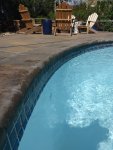My wife and I had a fiberglass pool installed late last summer and are looking to finish the job by installing coping. We will be using 2 cm thick exterior grade porcelain pavers (20" x 40"). We purchased the materials late last fall with most of the fabrication performed before delivery (custom cuts for the spa and bullnose profile) but did not initiate the job due to weather.
The tiles will cover the fiberglass lip and concrete bond beam but not extend out any further (grass will serve as the deck around the pool with the option of expanding the pavers over time should we desire -- please see attached image).
I spoke with a few masons with varied approaches/concerns regarding best installation method and none of them in agreement.
These can be installed in a variety of ways including sand base over gravel, thin set mortar, directly on grass, etc. Rather than mortar the paver to the bond beam I would consider attaching them to the 3 inch fiberglass lip using a constructive adhesive with sand used under the paver to allow for leveling and appropriate slope.
Curious to know your thoughts. Thanks!
The tiles will cover the fiberglass lip and concrete bond beam but not extend out any further (grass will serve as the deck around the pool with the option of expanding the pavers over time should we desire -- please see attached image).
I spoke with a few masons with varied approaches/concerns regarding best installation method and none of them in agreement.
These can be installed in a variety of ways including sand base over gravel, thin set mortar, directly on grass, etc. Rather than mortar the paver to the bond beam I would consider attaching them to the 3 inch fiberglass lip using a constructive adhesive with sand used under the paver to allow for leveling and appropriate slope.
Curious to know your thoughts. Thanks!








